This month we have two events coming up. First there will be our 'Ask a Horticultural Scientist' week on 15 - 22 May when anyone can submit questions to a new SCI forum to be answered by our team of horticultural scientists. In the same week, on 19 May, we will be joining with other groups in the Agri-Food Hub to put on an event on Biofortified and Functional Food: A Healthy Future? to show how the latest bioscience and agronomic technologies are being employed to increase the nutritional value of food and animal feed.
Editor
Medicinal Plants: From Crop to Cure?
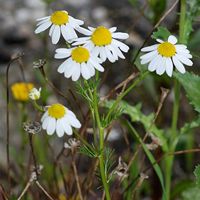
The seven speakers highlighted issues surrounding the current and potential uses for medicinal plant extracts. Throughout the day the importance of good experimental design was highlighted. In particular Chryssa Dimaki (Newcastle University) reported on her research using hydroponic Nutrient Film Technique (NFT) to cultivate aromatic and medicinal plants traditionally collected from the wild. This showed quality and quantity improvement in a controllable way, for essential oil extraction from such plants as Salvia fruticosa (Greek sage), Matricaria recutita (syn. M. chamomilla; camomile, Photo right by Alvesgaspar) and Origanum dictamus (hop marjoram) through the manipulation of nutrient balances within the hydroponic system. This form of cultivation is seen as a way of satisfying increasing demands for these crops as herbal remedies while helping to prevent habitat loss, degradation and loss of valuable species.
Many people believe that herbal remedies have no basis in science but Paul Chazot (Durham University) discussed the work carried out by his group in elucidating how components of lemon balm (Melissa officinalis) function to treat neurological illness. Frank Waimer (Schwabe GmbH) described what a complicated process the extraction of useful compounds from plants can be. Identifying the active/useful compound(s) can be highly challenging and then controlling the quality can also be very difficult. The use of quality assurance processes throughout, from use of the European Pharmacopeia and compliance with Good Agricultural and Collection Practice to Good Manufacturing Practice were discussed as important tools in achieving the desired quality assurance.
The high variability of plant derived extracts and the challenge this creates was very much a theme. David Potter (GW Pharmaceuticals Ltd) illustrated this in his talk about the medicinal use of Cannabis. GW Pharmaceuticals is licensed by the UK Home Office to grow Cannabis and to undertake research investigating the medicinal potential of the cannabinoids found in the plant. The company has launched a licensed drug, Sativex® which is an extract of the plant formulated as an oromucosal spray to treat the symptoms of Multiple Sclerosis.
The quality, consistency and efficacy of plant-based medicines is subject to Government regulation. Michael Heinrich (London University) described the difficulties in obtaining suitable 'clinical evidence'. Melanie Pires (Medicines and Healthcare Products Regulatory Agency) then discussed the mechanisms by which medicinal plant-based products can be licensed. It was very clear that there are difficulties for medicinal plant products in complying with regulations set up for conventional pharmaceuticals. An alternative form of registration (as Traditional Herbal Medicines) is not a route available to new products and the meeting felt that current regulation routes are not conducive to the commercial development of new products.
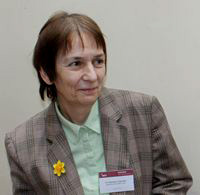
Lively question and answer sessions highlighted the need for academic researchers to think in a more commercial fashion and for commercial growers to engage more with academic researchers who have innovative new crops, which need to be grown. Altogether a stimulating, thought provoking and informative day.
- Conference downloads are available - click here
Marion Stainton and Alison Foster, Oxford Botanic Garden
Plant of the Month
Echinocactus grusonii (golden barrel cactus, Mother-in-law's cushion, Cactaceae)
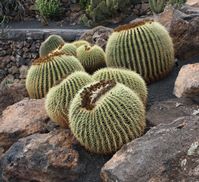
This cactus flowers in early summer, with a ring of yellow flowers sitting on the top of the plant amongst the deceptively furry looking central portion. The wild population was critically reduced by the creation of the Zimapan dam and reservoir in the 1990s and despite the widespread cultivation is under further threat from wild collection. If you do wish to enjoy this plants statuesque beauty then please ensure you source it from a reputable supplier.
Alison Foster, Oxford Botanic Garden
Medicinal Plant of the Month
Eucommia ulmoides (Eucommiaceae)
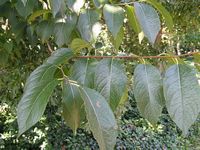

Alison Foster, Oxford Botanic Garden
News from our Associates
Commercial Horticultural Association
CHA Member, Russell IPM Ltd has been awarded The Queen's Award for Enterprise in recognition of the company's exceptional performance in International Trade over the last three years. 'This award is a big recognition to the hard work of every single member of staff who has helped to contribute to this achievement. It is a big thank you to all of our international partners, without their valued partnership and confidence this award would not have been possible. We aim to be able to continue to meet the high standards set by ourselves in order to obtain this award', commented Dr Nayem Hassan, Head of Research and Development at Russell IPM Ltd. More
Horticulture Industry News
For the very latest horticultural news follow us on Facebook and or
Twitter.
Herbal controls come into force

New directors at Kew
Dr Tim Entwisle has been appointed as Director of Conservation, Living Collections and Estates, and Prof Angela McFarlane as Director of Public Engagement and Learning at the Royal Botanic Gardens, Kew. Dr Tim Entwisle is a highly respected scientist and scientific communicator and joins Kew from the Royal Botanic Gardens and Domain Trust in Sydney, where he was Executive Director for over seven years. Prof Angela McFarlane came to the Royal Botanic Gardens, Kew on secondment in 2007 to take up the role of Director of Content and Learning from Bristol University, where she was Professor of Education.
Soil bacteria mapped
Britain's soil bacteria, which are essential for healthy and productive soils, have been mapped for the first time in a comprehensive study of the country's soil biodiversity. The results are published in the journal Environmental Microbiology. The scientific team, from the Centre for Ecology and Hydrology, Newcastle University and the University of Oxford, analysed over 1000 soil cores from England, Scotland and Wales, examining microbial DNA sequences in the laboratory to map bacterial biodiversity. The study concluded that bacterial diversity was strongly related to soil pH, with acidic soils dominated by few taxa. Below ground bacterial and above ground plant communities were closely related, suggesting that soil bacteria are driven by the same ecological processes that govern higher organisms such as plants.
African seed network
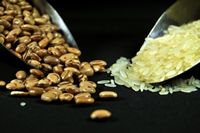
Bioportal to link Scottish science and industry
Links between Tayside's Life Sciences research institutes and businesses across Scotland are being strengthened through a funding package of more than £1m. This award will fund the ongoing work of the Innovation Portal, based at the University of Dundee. The BioPortal is an innovative new project designed to further enable Tayside research institutes to form stronger links with the Scottish life sciences industry by providing a match-making service of intellectual property and skilled post-doctoral researchers with needs of small-to-medium sized businesses, or SMEs. The BioPortal project has been designed and developed to address specific barriers that prevent effective transfer of innovation from research institutes to SMEs. More
Spin-off successes
Eleven universities have produced more than half of all the spin-off companies to have been launched by higher education institutions in the past 10 years, according to new figures. Spinouts UK, a newly launched database of information on the commercialisation of intellectual property in higher education, tracks the progress of spin-offs across the sector. An analysis of its data reveals that Imperial College London produced more spin-offs than any other UK university. It fostered 59 new companies from 2000 to 2010. The other high performers were also high-ranking research-intensive universities. Imperial was followed by the universities of Oxford (55 companies), Edinburgh (49), Cambridge (44), Warwick (36), Strathclyde (35), Newcastle (28), Bristol (28), Sheffield (28) and Queen's University Belfast and Leeds (both 25). Between them, these 11 universities fostered 412 of the 820 spin-off companies formed during the decade. More
UK's first Science Garden
Opening in June 2012, an outdoor space located at the front of Birmingham's Thinktank will be transformed into a permanent public landmark, where visitors of all ages can get 'bodies on' with large-scale interactive exhibits exploring some of the key science and engineering principles that shape the world we live in. The first of its kind to be built in the UK, the Science Garden will feature more than 40 interactive exhibits spread around three distinct areas: The Factory, The Street and The Garden.
Tannin increase may alter carbon cycle
Researchers conducted a study on the red maple, Acer rubrum, to find how levels of precipitation and temperature affected the concentration and structure of tannins in the leaves. When exposed to drought and high temperatures, maple leaf litter contained twice as many tannins. Because the litter contained more tannins by weight, and the tannins were more reactive, the researchers concluded that in a natural environment, leaf litter that falls from trees to the ground could interfere with enzymes in the soil slowing the breakdown and recycling of nutrients such as nitrogen. Decreased nitrogen availability may cause plants to take up less carbon dioxide; however, slower decomposition may also mean that the plants release less carbon into the environment.
Show disease the red light
The resilience of plants to, eg mildew may possibly be improved by using red light. Preliminary experiments by Wageningen UR Greenhouse Horticulture and Plant Research International show that light colour may influence plant resilience. Light from the red spectrum in particular seems important.
Corn Gromwell could replace fish oil
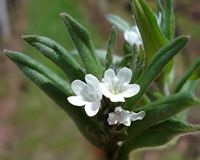
MEP's ignore their own science
The NFU has expressed its frustration after MEPs backed a proposal which would allow member states to ignore EU scientific advice and ban the cultivation of GM crops at a national level.
Environment Committee MEPs said member states should be allowed to disregard the EU's current authorisation procedure and make their own scientific assessment. Under their proposal, countries would be able to use environmental grounds, such as pesticide resistance or invasiveness of crops, to bring in national bans - even if EFSA had already deemed concerns unfounded. The vote was meant to toughen up European Commission proposals to allow member states to restrict or ban the cultivation of GM crops. But Dr Helen Ferrier, the NFU's Chief Scientific Advisor, said the MEPs were ignoring sound science and jeopardising food security.
Quotes of the Month
"The scientist is not a person who gives the right answers, it's one who asks the right questions."
Claude Lévi-Strauss
Events Calendar
Agriculture and Food for Development
10 May, All Party Parliamentary Group, Tropical Agriculture Association
London, UK
Microbial Horticulture
15 - 19 May, International Society for Horticultural Science
Alnarp, Sweden
Edible Alliaceae
16 - 19 May (postponement likely), International Society for Horticultural Science
Fukuoka, Japan
Food Safety - Can we ever be certain?
17 May, Institute of Food Science and Technology
London, UK
Postharvest Unlimited
23 - 26 May, International Society for Horticultural Science
Leavenworth, USA
BIAC AGM
25 May, British Institute of Agricultural Consultants
Tetbury, UK
Greensys 2011
5 - 11 Jun, International Society for Horticultural Science
Halkidiki, Greece
Sustainable Plant Protection Techniques in Fruit Growing
8 - 10 Jun, Centre Technique Interprofessionnel des Fruits et Légumes
Bergerac, France
Responsible Peatland Management and Growing Media Production
13 - 17 Jun, International Society for Horticultural Science
Quebec City, Canada
Future of Farming: What Needs to Change?
13 Jun, Tropical Agriculture Association and University of Reading
Reading, UK
Agricultural Ecology Research: its role in delivering sustainable farm systems
15 - 16 Jun, Association of Applied Biologists
Dundee, Scotland
Modelling in Fruit Research and Orchard Management
19 - 23 Jun, International Society for Horticultural Science
Saint-Jean-sur-Richelieu, Canada
Apricot Breeding and Culture
20 - 24 Jun, International Society for Horticultural Science
Yerevan, Armenia
The Landscaping Show
21 - 22 Jun, British Association of Landscape Industries
Stoneleigh, UK
Augmenting production and utilisation of mango; Biotic and abiotic stresses
21 - 23 Jun, International Society for Horticultural Science
Lucknow, India
Rubus and Ribes Symposium
22 - 26 Jun, International Society for Horticultural Science
Zlatibor, Serbia
Underutilised Plants: Crops for the Future - Beyond Food Security
27 Jun - 1 Jul, International Society for Horticultural Science
Kuala Lumpur, Malaysia
GM Crops: From Basic Research to Application
28 - 29 Jun, Association of Applied Biologists
Harpenden, UK
Turf Show
28 - 29 Jun, Turfgrass, Growers Association
Richmond, UK
National Plant Show
28 - 29 Jun, Horticultural Trades Association
Stoneleigh, UK
Landscape and Urban Horticulture
29 Jun - 3 Jul, International Society for Horticultural Science
Nanjing, China
Medicinal, Aromatic and Nutraceutical Plants from Mountainous Areas
6 - 9 July, International Society for Horticultural Science
Saas-Fee, Switzerland
Bee ecology and pollination in the agricultural landscape
7 July, Society of Biology
Hatfield UK
The Woking Show
13 July, The Woking Nurseries
Worplesdon, UK
Quality Management of Fresh Cut Produce: Convenience Food for a Tasteful Life
17 - 21 July, International Society for Horticultural Science
Turin, Italy
Fruit Focus
20 July, Haymarket Media Group
East Malling, UK
If you would like to advertise a forthcoming event please contact. zoe.daniel@soci.org
Horticulture Group Contact Details
For submitting ideas or to volunteer to be part of a committee or a group, please contact:
Chairman - Peter Grimbly
Meetings Secretary - Marion Stainton
Minutes Secretary - Margaret Waddy
Newsletter Co-ordinator - Sue Grimbly, E: scihortigroup@btinternet.com
Group Coordinator - Zoe Daniel zoe.daniel@soci.org T: +44 (0)20 7598 1594
